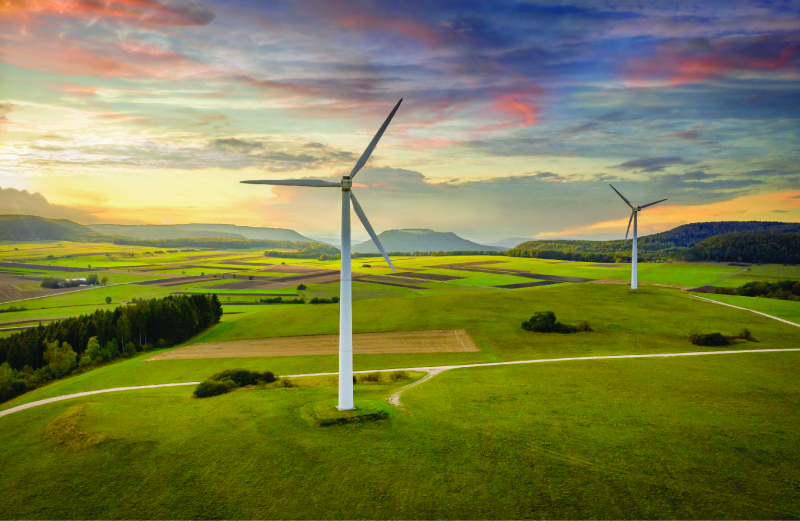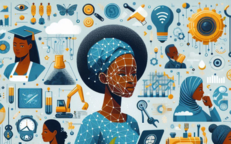Harnessing Wind Energy To Bolster Africa’s Socio-Economic Development

This is the 20th post in a blog series to be published in 2021 by the Secretariat on behalf of the AU High-Level Panel on Emerging Technologies (APET) and the Calestous Juma Executive Dialogues (CJED)
Approximately 640 million Africans do not have reliable access to electricity if any, and about 900 million Africans lack access to clean cooking energy sources. That means the per capita energy consumption in sub-Saharan Africa, excluding South Africa, is approximately 180 kWh. This is less than the 13,000 kWh per capita observed in the United States of America and 6,500 kWh in Europe.[1] As such, African governments have the precarious task of addressing the persistent lack of access to electricity and clean cooking energy. This includes the unreliability of electricity supply, which has negatively impacted Africa’s socio-economic development.
Aspiration 2 of the African Union’s Agenda 2063 seeks to address energy challenges in Africa and bring solutions towards developing world-class infrastructure and reliable energy sharing networks across the African continent. This can potentially enhance energy sharing and connectivity through newer and bolder frameworks, programmes and initiatives that can link the continent by rail, road, sea, and air. Africa can achieve such ambitions through developing regional and continental power pools empowered by reliable energy technologies.[2]
The continent’s level of development has underscored Africa’s need for energy. Notably, affordable and clean energy production and supply among the United Nations’ Sustainable Development Goals to enable robust socio-economic development across the continent. It has been shown that African countries with limited electrification rates turn to have lower GDP per capita characterised by minimal socio-economic development.[3] However, developing African countries with reliable and adequate electricity can enjoy increased national productivity as a precursor of socio-economic development. Thus, access to reliable energy sources is not only imperative to the attainment of robust health and education outcomes but also towards reducing the cost of doing business, unlocking socio-economic potential, and job creation.[4]
Africa is endowed with a considerable potential of fossils, solar energy, wind energy, hydro energy, and geothermal energy. However, the continent still suffers from a severe energy deficit. Notably, renewable energy sources are increasingly being favoured as a clean energy option in Africa to address environmental concerns, global warming, and climate change. In addition, developing this industry can become an economical option and create jobs for Africans. For example, developing the accompanying wind energy consumables, technologies, facilities, and equipment can boost science, engineering, and technology job creation endeavours for the African countries. This can be realised through enhanced industrial activities such as manufacturing, installation, research and development, entrepreneurship, and innovation, among other jobs created in the value chain
Wind energy can be an alternative source of energy on the continent if properly harnessed. However, the upfront costs of installing wind farms and turbines can be costly. However, when looking at the benefits such as the cost-effective running and operational costs, and freely available wind, African countries can save tremendously in the long term. In addition, wind turbines do not require expensive maintenance protocols and operations over the course of their lifetime.[5] Furthermore, wind energy does not pollute the environment, such as power plants that rely on the combustion of fossil fuels. The disadvantage of fossil fuels is their emission of particulate matter such as nitrogen oxides and sulfur dioxide that pollute the environment, cause human health problems, global warming, and economic damages. As such, the advantage of wind energy turbines is that they do not produce atmospheric greenhouse gases emissions that can cause acid rain and smog, among other challenges.
However, to fully realise this industry and enjoy the benefits, the African Union High Level Panel on Innovation and Emerging Technologies (APET) encourages African governments to formulate clear strategic and regulatory frameworks that can enable wind energy generation and surrounding economic activities to thrive and supply reliable electricity through microgrids (see APET Report titled, “Micro-Grids - Empowering Communities and Enabling Transformation in Africa”. As it is, with the exception of the North African countries and South Africa, no other African country has significantly implemented and boosted their wind energy industry across the continent.[6]
Assessing and improving the socio-economic viability of wind power generation is certainly paramount towards the developmental growth potential of the wind industry that can reliably supply electricity to various African communities. Furthermore, renewable energy costs have significantly decreased over the last few years. However, capital costs have remained a major financial concern for African countries and small businesses. Not only are wind turbines expensive, but they lack storage capacities. Thus, African governments challenged to mobilise funds that can address these financial challenges to make wind energy installation cost-effective and enable comprehensive electricity management and storage capacities through the Next Generation Batteries.
African countries such as Ethiopia are benefitting from the abundance of wind energy sources. As such, the Ethiopian government has recognised the potential for harnessing wind energy source to bolster socio-economic growth. Consequently, the wind energy sector has boosted Ethiopia’s energy-exporting capacity through the diversification of electricity generation. Notably, located in Ashegoda, near Mekelle in the Tigray region, approximately 780 km north of the Ethiopian capital, Addis Ababa, a wind farm with a capacity of 120 MW supplies electricity to more than 3 million Ethiopians. The powerful wind resource allows the Ethiopian Electric Power Corporation to deliver electricity at a low cost.[7]
In conclusion, APET is encouraging African countries to commit funding investments and infrastructural frameworks towards alternative renewable energies such as wind energy as their national socio-economic development frameworks. Since Africa has numerous clean energy sources, the continent should consider pioneering the utilisation of green energy projects and programmes for Africans. Notably, developing adaptable and affordable clean energy solutions is a prerequisite for the socio-economic development of the continent. Finally, it is time for Africa to light up the continent as we move towards achieving Agenda 2063, “The Africa We Want”.
Featured Bloggers – APET Secretariat
Justina Dugbazah
Barbara Glover
Bhekani Mbuli
Chifundo Kungade
[1] https://www.afdb.org/en/the-high-5/light-up-and-power-africa-%E2%80%93-a-new-deal-on-energy-for-africa
[2] https://au.int/en/infrastructure-energy-development
[3] https://unctad.org/system/files/official-document/aldcafrica2018_en.pdf.
[4] https://www.afdb.org/en/the-high-5/light-up-and-power-africa-%E2%80%93-a-new-deal-on-energy-for-africa
[5]https://www.energysage.com/about-clean-energy/wind/pros-cons-wind-energy/
[6] https://www.afdb.org/en/the-high-5/light-up-and-power-africa-%E2%80%93-a-new-deal-on-energy-for-africa
[7] http://www.vergnet.com/project/ethiopia-ashegoda/


